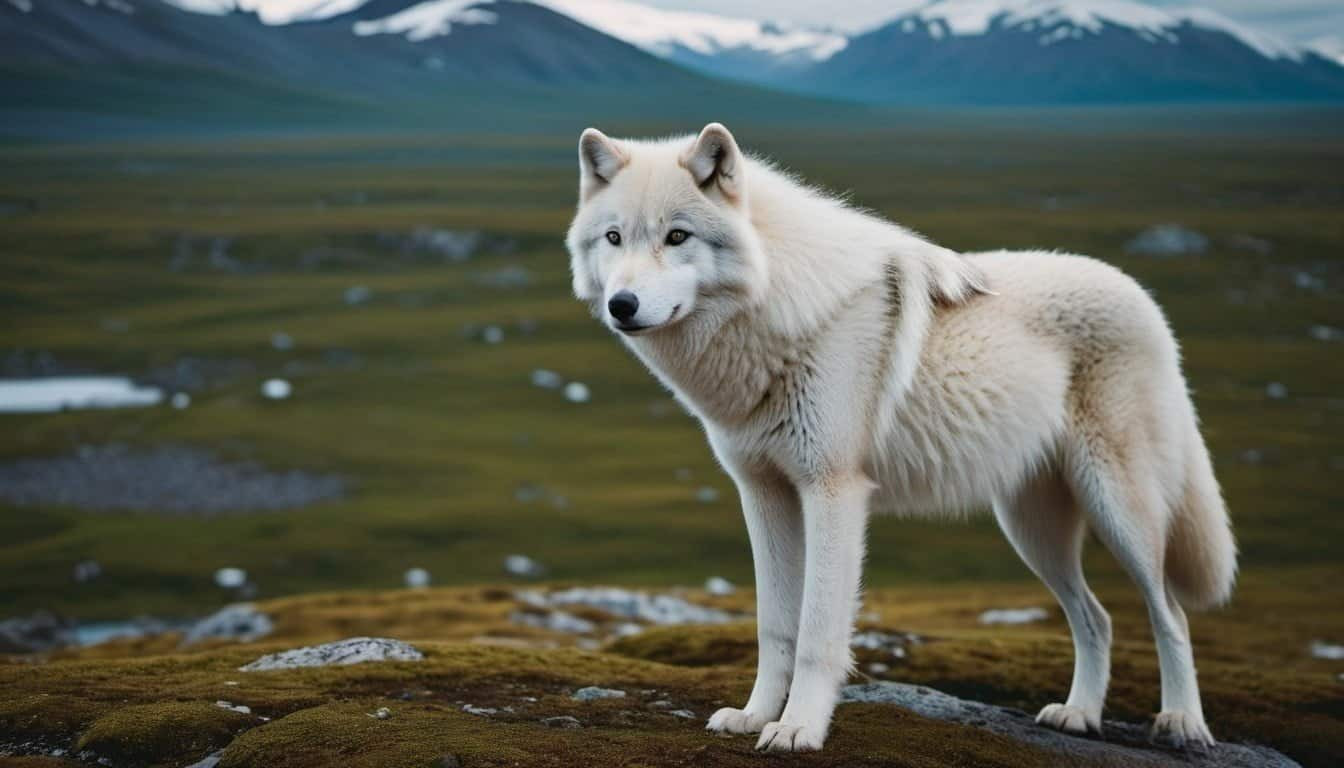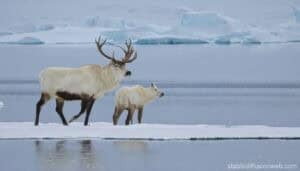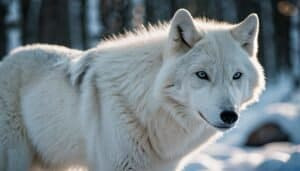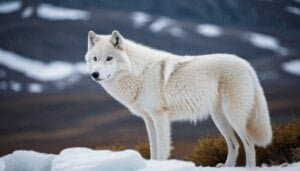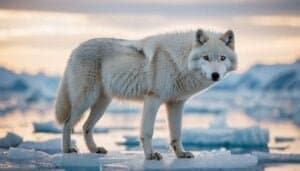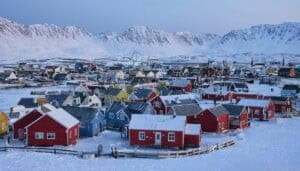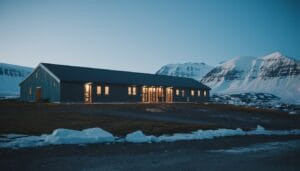Introduction
Arctic wolves are a key species within the Arctic ecosystem, and their study provides crucial insights into the delicate balance of this extreme environment. Researchers have dedicated significant effort to understanding these resilient creatures, from their roles as predators to their interactions with other species
This article explores the importance of Arctic wolves in the ecosystem, the methods used to study them, the significant findings of these studies, and the challenges faced by researchers
Additionally, it delves into the conservation efforts aimed at ensuring the survival of Arctic wolves in the face of climate change and other threats
The Role and Impact of Arctic Wolves in the Ecosystem
Arctic wolves (Canis lupus arctos) play a vital role in maintaining the ecological balance of the Arctic region. These apex predators have adapted to one of the harshest environments on Earth and have significant impacts on the populations and behaviors of their prey and other species within their habitat
Understanding their role in the Arctic ecosystem provides insights into the intricate web of life in this unique and fragile environment
Predator-Prey Relationships
Arctic wolves primarily prey on large herbivores such as caribou (Rangifer tarandus) and musk oxen (Ovibos moschatus). These predator-prey dynamics are crucial for regulating the populations of these herbivores, preventing overgrazing, and maintaining the health of the tundra ecosystem
By controlling the numbers of caribou and musk oxen, Arctic wolves help ensure that vegetation can regenerate, which in turn supports a variety of other species, from small mammals to birds and insects
Studies have shown that Arctic wolves often hunt in packs, which allows them to take down larger prey that would be difficult to capture alone. This pack behavior not only enhances their hunting success but also fosters social bonds and cooperative strategies within the wolf community
The presence of wolves can cause changes in the behavior of their prey, such as altered grazing patterns and increased vigilance, which further influences the distribution and abundance of vegetation in the Arctic
In a study conducted in 2018, researchers observed that the presence of Arctic wolves led to a more balanced and diverse plant community, as areas with fewer herbivores allowed for a greater variety of plant species to flourish (Mech & Boitani, 2018). This demonstrates the critical role that Arctic wolves play in maintaining the biodiversity and resilience of their ecosystem
Impact on Biodiversity
The influence of Arctic wolves extends beyond their direct interactions with prey species. As top predators, they create a cascade of effects that benefit other species and the overall biodiversity of the Arctic
For instance, when wolves reduce the populations of dominant herbivores, they indirectly support smaller herbivores and other wildlife that might otherwise be outcompeted for resources
Moreover, wolf predation can provide scavenging opportunities for a variety of species, including birds like ravens (Corvus corax) and smaller mammals such as Arctic foxes (Vulpes lagopus). These scavengers rely on the remains of wolf kills to supplement their diets, especially during the harsh winter months when food is scarce
The presence of wolves thus helps sustain a complex web of interactions among various species, contributing to the overall health and stability of the ecosystem
Research published in 2020 highlighted that the decline or absence of Arctic wolves can lead to overpopulation of certain herbivore species, resulting in habitat degradation and a loss of biodiversity (Smith et al., 2020)
This underlines the importance of conserving wolf populations to preserve the ecological integrity of the Arctic region
Research Methods and Key Findings
The study of Arctic wolves involves a range of research methods that help scientists gather data on their behavior, genetics, and interactions within the ecosystem
These methods have provided valuable insights into how Arctic wolves have adapted to their environment and how they influence the Arctic ecosystem
Tracking and Observation Techniques
Tracking and observing Arctic wolves in their natural habitat is challenging due to the remote and harsh conditions of the Arctic. Researchers use a variety of techniques to monitor wolf movements and behavior
One common method is the use of GPS collars, which allow scientists to track the wolves’ locations and movements in real time. These collars provide data on the wolves’ home ranges, hunting patterns, and interactions with other packs and species
In addition to GPS collars, researchers often rely on direct observation and remote camera traps. Direct observation involves following wolf packs, either on foot or using snowmobiles, to record their behavior and interactions
This method can provide detailed insights into pack dynamics, hunting strategies, and social structures. Remote camera traps, placed at strategic locations such as dens or frequently used trails, capture images and videos of wolves as they go about their daily activities. These camera traps can operate year-round, offering a continuous stream of data even during the harsh winter months
A study published in 2017 used GPS collars to track the movements of Arctic wolves on Ellesmere Island, revealing that the wolves traveled extensive distances, sometimes exceeding 31 miles (50 kilometers) in a single day, to hunt and patrol their territories (Musiani et al., 2017)
This extensive mobility highlights the adaptability and resilience of Arctic wolves in their quest for food and survival
Genetic and Behavioral Studies
Genetic studies are another crucial aspect of Arctic wolf research. By analyzing DNA samples collected from wolves, researchers can gain insights into their genetic diversity, population structure, and evolutionary history
These studies often involve collecting tissue samples from captured wolves or using non-invasive methods such as collecting hair or fecal samples
Genetic analyses have revealed that Arctic wolves are genetically distinct from other gray wolf populations, with adaptations that enable them to thrive in the extreme Arctic environment
For instance, a study published in 2019 found that Arctic wolves have unique genetic markers associated with cold tolerance, which likely contribute to their ability to survive in sub-zero temperatures and snowy conditions (Hendricks et al., 2019). Understanding these genetic adaptations can provide valuable information for conservation efforts, as it highlights the importance of preserving the unique genetic makeup of Arctic wolves
Behavioral studies, often conducted in conjunction with tracking and genetic research, focus on the social structures, communication methods, and reproductive behaviors of Arctic wolves
These studies have shown that Arctic wolf packs are typically smaller than those of other gray wolf populations, often consisting of a single family unit with a dominant breeding pair and their offspring. This social structure is likely an adaptation to the limited prey availability in the Arctic
In terms of communication, Arctic wolves use a variety of vocalizations, body postures, and scent marking to communicate with each other and establish territory boundaries
Observational studies have documented the complex social interactions within wolf packs, including cooperative hunting, pup rearing, and territorial defense. These behaviors emphasize the importance of social cohesion and cooperation for the survival of Arctic wolves in their challenging environment
Adaptations to Arctic Conditions
Arctic wolves have developed a range of physiological and behavioral adaptations that enable them to survive in the extreme conditions of the Arctic. One of the most notable adaptations is their thick fur, which provides insulation against the cold and protection from the wind
This fur is composed of a dense undercoat and longer guard hairs, which trap heat close to the body
Another key adaptation is their ability to endure long periods without food. Arctic wolves can survive for weeks without a substantial meal, relying on their fat reserves and a slow metabolism to sustain them during times of scarcity
When food is available, they are capable of consuming large quantities in a single feeding, which helps them build up fat reserves for leaner times
Behaviorally, Arctic wolves exhibit a high degree of mobility, traveling long distances to find prey and avoid competition. This mobility is facilitated by their strong, muscular legs and large paws, which act like snowshoes to prevent them from sinking into the snow. Additionally, Arctic wolves are opportunistic feeders, capable of hunting a variety of prey species and scavenging when necessary
A study published in 2016 highlighted the importance of these adaptations, showing that Arctic wolves have a higher survival rate in areas with abundant prey and lower human disturbance, underscoring the need to protect their natural habitats from encroachment and climate change (Mech, 2016)
Social Structure and Behavior
The social structure of Arctic wolves is centered around the pack, which typically consists of a dominant breeding pair and their offspring
This family unit is the cornerstone of Arctic wolf society, providing stability and support for raising pups and hunting. The dominant pair leads the pack, making decisions about movements, hunting, and territory defense
Pack cohesion is maintained through a complex system of communication and social behaviors. Wolves use vocalizations such as howls, growls, and barks to communicate with pack members and signal their presence to other packs. Howling serves multiple purposes, including coordinating group movements, strengthening social bonds, and establishing territory boundaries
Within the pack, there is a clear hierarchy, with the dominant pair at the top and subordinate members below
This hierarchy is reinforced through body language, scent marking, and social interactions. Subordinate wolves show submission to the dominant pair through behaviors such as crouching, tail tucking, and licking the dominant wolves’ muzzles
Reproduction is typically limited to the dominant pair, which ensures that resources are focused on raising a single litter of pups each year
The entire pack participates in caring for the pups, with subordinate wolves helping to hunt and provide food. This cooperative breeding strategy increases the chances of pup survival in the harsh Arctic environment
Challenges and Conservation of Arctic Wolves
Arctic wolves face numerous challenges that threaten their survival and well-being. These challenges stem from environmental, logistical, and ethical issues that complicate both their existence in the wild and the research conducted to understand them better
Additionally, climate change and human activities further exacerbate these challenges, highlighting the need for effective conservation strategies
Environmental and Logistical Challenges
The Arctic environment is one of the most extreme and inhospitable regions on Earth
Arctic wolves must contend with severe cold, limited food availability, and long periods of darkness during the winter. These harsh conditions not only test the wolves’ resilience but also pose significant challenges for researchers trying to study them
Fieldwork in the Arctic requires specialized equipment and logistics. Researchers often need to travel long distances over treacherous terrain, using snowmobiles, helicopters, or even dog sleds
Setting up research camps in such remote areas is both costly and labor-intensive. Furthermore, the Arctic’s extreme weather can disrupt research plans, with blizzards, freezing temperatures, and limited daylight hours making fieldwork difficult and dangerous
In a study published in 2015, researchers detailed the logistical hurdles they faced while studying Arctic wolves on Ellesmere Island, including transportation issues, limited communication infrastructure, and the need for emergency preparedness in such a remote location (Harrington et al., 2015). These challenges underscore the dedication and resourcefulness required to conduct research in the Arctic
Ethical Considerations in Research
Ethical considerations are paramount in wildlife research, particularly when studying species like Arctic wolves
Researchers must balance the need for data with the welfare of the animals being studied. Invasive techniques, such as capturing and collaring wolves, can cause stress and injury if not done carefully. Consequently, ethical guidelines and protocols are established to minimize harm and ensure the humane treatment of Arctic wolves
One ethical concern is the potential disturbance to wolf packs during critical periods, such as denning and pup rearing. Human presence near dens can lead to abandonment or stress, negatively impacting pup survival rates
To mitigate these risks, researchers often employ non-invasive methods, such as remote camera traps and environmental DNA sampling, to gather data without directly interacting with the wolves
Additionally, obtaining proper permits and adhering to regulations is essential. Researchers must work with local and indigenous communities, respecting their knowledge and traditions regarding Arctic wildlife. Collaborative approaches that incorporate traditional knowledge can enhance the ethical and cultural sensitivity of research projects
A 2018 review of wildlife research ethics emphasized the importance of transparency, accountability, and community involvement in studies involving Arctic wolves (Macdonald et al., 2018). This approach not only ensures ethical standards are met but also fosters trust and cooperation between researchers and local communities
Climate Change and Arctic Wolves
Climate change poses one of the most significant threats to Arctic wolves and their ecosystem
The Arctic is warming at more than twice the global average rate, leading to profound changes in the environment. Melting sea ice, thawing permafrost, and shifting vegetation patterns are altering the landscape that Arctic wolves depend on
As their habitat changes, Arctic wolves face new challenges in finding prey and maintaining their territories. For example, changes in the distribution and migration patterns of caribou and musk oxen, their primary prey, can impact the wolves’ hunting success and survival rates
Additionally, warming temperatures may facilitate the northward expansion of other predators, such as coyotes and red foxes, increasing competition for resources
Research published in 2020 highlighted the impacts of climate change on Arctic wolf populations, noting that increased human activity, such as shipping and resource extraction, further threatens their habitat (Post et al., 2020). These findings underscore the urgent need for climate action and habitat protection to safeguard the future of Arctic wolves
Conservation Efforts and Policies
Conservation efforts for Arctic wolves focus on protecting their habitat, mitigating human impacts, and ensuring sustainable populations. Effective conservation strategies require a combination of scientific research, policy measures, and community involvement
Protected areas play a crucial role in conserving Arctic wolves by providing safe habitats free from human disturbance. Establishing and maintaining these areas involves collaboration between governments, conservation organizations, and indigenous communities. Policies that regulate industrial activities, such as mining and oil drilling, in and around these protected areas are essential to minimize habitat degradation
Public awareness and education campaigns are also vital for promoting the conservation of Arctic wolves. By raising awareness about the ecological importance of these predators and the threats they face, conservationists can garner support for protective measures and funding for research initiatives
International cooperation is another key component, given that Arctic wolves inhabit territories spanning multiple countries. Cross-border conservation initiatives and agreements, such as those facilitated by the Arctic Council, can help coordinate efforts to protect these wolves and their habitat on a larger scale
A 2022 report by the World Wildlife Fund (WWF) emphasized the importance of integrating traditional knowledge into conservation strategies, highlighting successful examples of community-led initiatives in the Arctic (WWF, 2022)
Such collaborative approaches not only enhance the effectiveness of conservation efforts but also respect and empower indigenous communities who have coexisted with Arctic wolves for generations
Conclusion
Arctic wolves play a pivotal role in the Arctic ecosystem, serving as apex predators that regulate herbivore populations and maintain biodiversity
Research on these resilient animals employs a variety of methods, including tracking, genetic studies, and behavioral observations, to uncover their adaptations and social structures. However, studying Arctic wolves poses significant environmental and logistical challenges, compounded by ethical considerations that ensure their humane treatment
The impact of climate change on Arctic wolves is profound, altering their habitat and food sources while introducing new competitors. Conservation efforts are critical in addressing these threats, involving habitat protection, regulatory policies, public awareness, and international cooperation
Integrating traditional knowledge and scientific research further enhances these efforts, fostering a comprehensive approach to conservation
Arctic wolves are integral to the health of the Arctic ecosystem, and their preservation requires a concerted effort from scientists, policymakers, and communities. By understanding and addressing the challenges they face, we can ensure the continued survival and ecological significance of Arctic wolves in a rapidly changing world
